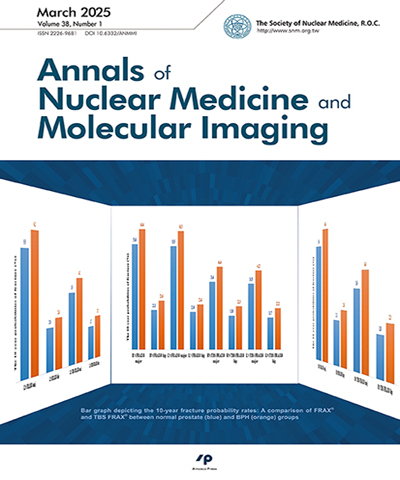
核子醫學暨分子影像雜誌/Annals of Nuclear Medicine and Molecular Imaging
中華民國核醫學學會 & Ainosco Press,正常發行
選擇卷期
- 期刊
Background: Many studies had proven the relationship between liver disease and bone mineral density (BMD). Glutamic-oxaloacetic transaminase (GOT) and glutamic-pyruvic transaminase (GPT) are indicators of liver damage, but few studies have explored the relationship between the GOT/GPT ratio and BMD. This retrospective study aimed to develop a model for predicting the GOT/ GPT ratio using BMD values. Methods: Data was collected from patients attending a physical examination center of a regional hospital in southern Taiwan, from June 2014 to July 2020. We excluded subjects with hepatitis B virus, hepatitis C virus, a history of drinking, and GOT > 40 U/L. GOT, GPT, and the GOT/GPT ratio were analyzed using univariate linear regression for the relationship between these values and demographic and clinical factors. Univariate and multivariate linear regression analyses were used to determine the association between GOT/GPT and BMD values (lumbar spine, right hip neck area, right hip total area, left hip neck area, and left hip total area). Results: The study included 13,542 subjects, with a mean of age 56.8 ± 11.6 years, body mass index (BMI) 23.9 ± 3.4 kg/m^2, GOT 21.4 ± 6.1 U/L, GPT 27.2 ± 11.9 U/L, and GOT/ GPT 0.87 ± 0.31. Univariate linear regression analysis showed that GOT/GPT was negatively correlated with each measure of BMD (r = -0.202 to -0.126, p < 0.001). In multivariate linear regression analysis, adjusted for BMI, fasting blood glucose, systolic blood pressure, total cholesterol, triglycerides, uric acid, exercise, and smoking history, GOT/GPT also correlated negatively with each measure of BMD (r = -0.102 to -0.051, p < 0.001). The adjusted model of BMD explained 12.2-18.9% of GOT/GPT. Conclusions: We found that the higher the GOT/GPT ratio, the more severe the liver cirrhosis. The GOT/GPT ratio also revealed that BMD was significantly negatively correlated with liver cirrhosis. Therefore, patients with liver cirrhosis need to care for their bone health, too.
- 期刊
近年來人工智慧(artificial intelligence)進步神速,應用這項科技於指紋辨識、人臉辨識、車牌辨識、瞳孔辨識、掌紋辨識、機器視覺、專家系統、自動規劃等等,已經對人類的生活產生了不可思議的影響。應用「卷積神經網路」(convolutional neural network)來判讀核醫科常見的「全身骨骼掃描」影像判讀診斷,國外學者已有幾個初步的研究。本研究取材於國內醫學中心的影像,隨機選出60組影像,其中包括(1)正常影像22組、(2)具有退化性表現的影像25組以及(3)多發性骨骼轉移的影像13組。部分影像用於訓練卷積神經網路,其他的影像用於驗證卷積神經網路判讀診斷的正確性。初步研究結果,判讀影像的正確率為86.7%。相信在不久的將來,人工智慧應用於核醫科常見影像的判讀診斷,將會逐漸開發出驚人的成果。
- 期刊
An 81-year-old man had a history of bronchogenic adenocarcinoma diagnosed after a computed tomography (CT) guided biopsy. A stage IB disease was assigned by fluorodeoxyglucose (FDG) positron emission tomography (PET)/CT performed for the cancer staging. An incidental finding of ovoid intense FDG activity bulging out the urinary bladder was demonstrated in the dual-time-point scan. After administration of diuretics, the delayed phase scan was taken and the intense FDG activity was still noted. A bladder neoplasm or metastasis was considered initially, but there was no suspicious soft tissue density in the corresponding CT images. On the contrary, there was a bulging fluid-density pouch in the bladder wall and a bladder diverticulum with entrapped radioactive urine was diagnosed.
- 期刊
A 42-year-old male had fever and body aches for one day. Physical examination showed hidradenitis suppurativa (HS) over buttock for years, with right buttock redness noted. The laboratory data showed leukocytosis with elevated C-reactive protein. Debridement of right buttock HS showed acute inflammation with abscess formation. For infection survey, Ga-67 scan with single photon emission tomography/computed tomography, arranged after inflammatory markers were unresolved after antibiotics, showed generalized HS involving right posterior neck, right axilla, right medial thigh, bilateral buttock, and left groin. Except HS, no other gallium-avid infectious or inflammatory lesions shown on Ga-67 scan. Debridement of right thigh and left inguinal regions with culture showed HS with Prevotella disiens and Prevotella bivia growth.
- 期刊
A 64-year-old man with known diabetes mellitus and uremia was under regular hemodialysis. He complained recent dizziness, vomiting, and gait disturbance. Right side hearing impairment, right side earache, and leukocytosis were noted. He went for a head magnetic resonance imaging scan which revealed a tumor in the right paramedian cerebellum and the right mastoiditis. The cerebellum tumor was suspected of metastasis of unknown origin. Then he was referred for a whole-body ^(18)F-fluorodeoxyglucose (FDG) positron emission tomography/computed tomography. The result showed increased FDG uptake in the right mastoid and faint tracer uptake in the right cerebellum region. The mastoiditis subsided after antibiotic treatment, and pain was relieved, white blood cell and differential count returned to normal range soon after. He received suboccipital craniotomy and removal of tumor. Histopathology revealed cerebellar capillary hemangioblastoma. The tumor is usually well-circumscribed with a highly vascular mural nodule almost always abutting pial layer and a peripheral cyst which has similar contents as blood plasma.

